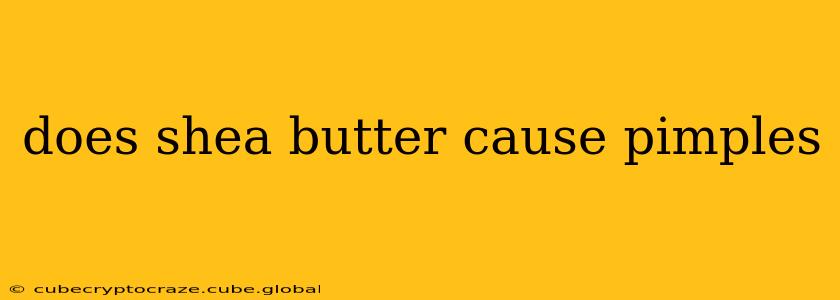Shea butter, a natural fat extracted from the shea nut tree, has gained immense popularity for its moisturizing and skin-soothing properties. However, a common concern among potential users is whether shea butter can actually cause pimples. The answer, like many things related to skincare, isn't a simple yes or no. Let's delve into the complexities of shea butter and its potential impact on acne-prone skin.
What is Shea Butter?
Before addressing the pimple question, let's understand what shea butter is. It's rich in fatty acids, vitamins (like vitamin E), and other beneficial compounds that contribute to its moisturizing and anti-inflammatory effects. These properties make it attractive for treating dry skin, eczema, and other skin conditions. However, its composition is also key to understanding its potential to clog pores.
Can Shea Butter Clog Pores?
This is the crux of the matter. While shea butter is generally considered non-comedogenic (meaning it shouldn't clog pores), its comedogenicity can vary depending on several factors:
- Refinement Process: Raw, unrefined shea butter contains more impurities that might be more likely to clog pores than refined shea butter. Refined shea butter undergoes processing to remove some of these impurities.
- Skin Type: Individuals with oily or acne-prone skin might be more susceptible to breakouts, even with non-comedogenic products. The oiliness of the skin can combine with the shea butter's oil content, potentially leading to clogged pores.
- Amount Used: Applying excessive amounts of shea butter, regardless of its refinement, can overwhelm the skin and contribute to clogged pores. Moderation is key.
- Other Ingredients: If the shea butter is part of a product containing other comedogenic ingredients (like certain oils or silicones), the likelihood of breakouts increases.
Does Shea Butter Cause Pimples? A More Nuanced Answer
The truth is, shea butter itself is unlikely to directly cause pimples for most people. However, its potential to clog pores, especially for those with oily skin or when used excessively, means it could contribute to breakouts. Therefore, it's more accurate to say that shea butter's relationship with pimples is conditional rather than causal.
What About the "Comedogenic" Rating?
You might encounter different comedogenicity ratings for shea butter. These ratings attempt to quantify a product's pore-clogging potential, but they're not always consistent across sources. Furthermore, individual reactions can vary. A product rated as non-comedogenic might still cause breakouts for some individuals.
How to Use Shea Butter Without Breakouts
If you have acne-prone skin and want to try shea butter, consider these tips:
- Start with a small amount: Apply a tiny amount to a small area of your skin to check for any reaction before applying it to your entire face.
- Opt for refined shea butter: Refined shea butter has undergone processing to remove impurities, making it less likely to clog pores.
- Use it sparingly: Don't overdo it. A little goes a long way, especially for oily skin.
- Combine it with other acne-fighting ingredients: Consider using shea butter in conjunction with other products known for their acne-fighting properties (under the guidance of a dermatologist).
- Pay attention to your skin's reaction: If you notice any breakouts, discontinue use.
Frequently Asked Questions (FAQs)
Is unrefined shea butter better than refined shea butter for the skin?
While unrefined shea butter often retains more of its natural vitamins and antioxidants, it may also contain more impurities that could potentially clog pores and lead to breakouts in some individuals. Refined shea butter undergoes processing to remove some of these impurities, making it potentially a better choice for acne-prone skin. The best choice depends on your skin's specific needs and tolerance.
Can I use shea butter as a daily moisturizer if I have acne-prone skin?
Possibly, but use caution. If you have acne-prone skin, start by using a small amount of refined shea butter only on certain areas or a few times a week. Monitor your skin’s reaction carefully. If breakouts occur, reduce the frequency of use or discontinue use entirely. Always remember that individual reactions can vary.
What are some alternatives to shea butter for moisturizing acne-prone skin?
Several other moisturizers are well-suited for acne-prone skin and are less likely to clog pores. These can include lightweight lotions containing ingredients like hyaluronic acid or glycerin. Consulting with a dermatologist can help determine the best moisturizer for your specific skin type and concerns.
Is shea butter good for all skin types?
While shea butter is generally considered safe and beneficial for many, individuals with extremely sensitive or acne-prone skin should always perform a patch test first. If irritation or breakouts occur, discontinue use.
Ultimately, whether shea butter causes pimples is highly dependent on individual skin type, the type of shea butter used, and the amount applied. By understanding these factors and taking precautions, you can determine if this natural moisturizer is suitable for your skincare routine. When in doubt, consult a dermatologist for personalized advice.
